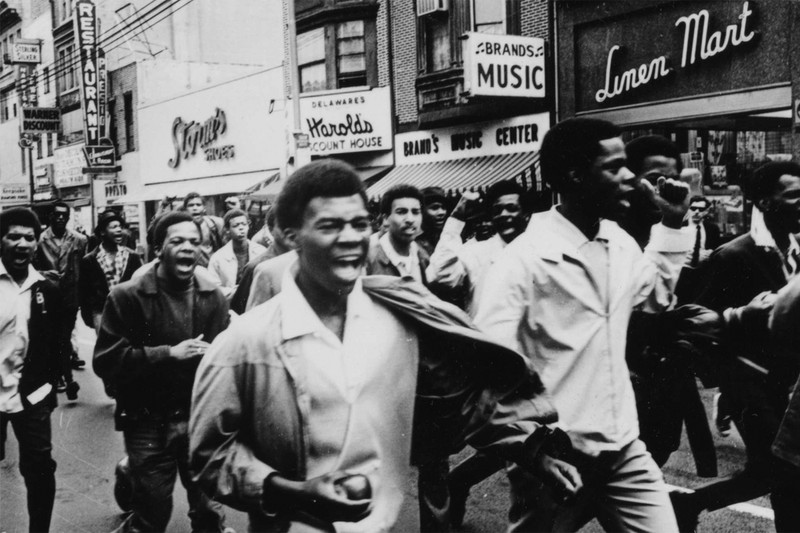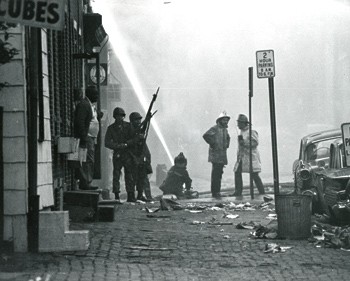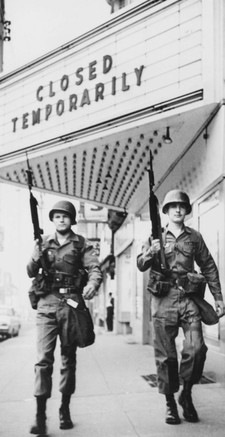Rodney Square and the Wilmington Riots of 1968
Introduction
Text-to-speech Audio
In the aftermath of Martin Luther King, Jr.'s assassination in April of 1968, cities across the United States experienced a wave of riots and violence. Following a memorial for Dr. King that was held in Rodney Square three days after the assassination, angry residents began rioting in the city. There are disagreements about the extent of the damage, but in response to the rioting, Delaware governor ordered 2,800 National Guardsmen to the city to maintain order. They remained in the city for nine months, long after the rioting ended.
Images
Marchers on Wilmington's Market Street

Some of the damage caused by the riots

National Guardsmen on duty in Wilmington

Backstory and Context
Text-to-speech Audio
On April 4, 1968, Martin Luther King, Jr., was assassinated in Memphis. News reports of the assassination triggered riots in numerous American cities in the following days, while Wilmington remained largely calm, with only minor disturbances. On Sunday, April 7, there was a gathering of several hundred people in Rodney Square to honor Dr. King and his legacy. The memorial was peaceful, but moments afterward, protesters took to the streets.
On the afternoon and evening of April 8, the mood in Wilmington became angrier. A group of African-American men who called themselves the "Goon Squad" and patrolled the city's streets attempting to prevent gang violence were assaulted by teens throwing rocks. Local ministers and representatives from the NAACP urged calm to no avail. Governor Charles Terry declared a state of emergency in the city and activated over 1,000 National Guard troops, but after the 10:30 PM curfew passed, it appeared that the worst was over.
Over the next two nights, however, rioting spread through West Center City. Historians differ on the extent of the damage caused by rioting. Roughly fifteen buildings--some of which were slated for demolition--were destroyed by arson. Several dozen people were injured, and nearly 160 people were arrested on the April 9 and 10.
On April 9, Governor Terry ordered 2,800 National Guardsmen to Wilmington to maintain order, and many residents expected that the troops would be removed once the rioting ended. Though the rioting in Wilmington was short-lived and led to comparatively minimal damage, the governor announced his plans to keep the National Guard in the city until it was safe. The troops remained in Wilmington for nine months--the longest occupation of an American city since the Civil War.
Wilmington of 1968 was a divided city before the occupation. The construction of I-95 through the city led to the destruction of numerous inner city neighborhoods and led to lingering bad blood. There was two days of race-related riots in July of 1967. But the prolonged occupation of the city in 1968-69 heightened the distrust that many residents felt toward the government. Many working-class families left West Center City and other inner city neighborhoods in the aftermath, and many businesses and white families fled to the suburbs. That part of Wilmington has never completely rebounded from the events of 1968.
On the afternoon and evening of April 8, the mood in Wilmington became angrier. A group of African-American men who called themselves the "Goon Squad" and patrolled the city's streets attempting to prevent gang violence were assaulted by teens throwing rocks. Local ministers and representatives from the NAACP urged calm to no avail. Governor Charles Terry declared a state of emergency in the city and activated over 1,000 National Guard troops, but after the 10:30 PM curfew passed, it appeared that the worst was over.
Over the next two nights, however, rioting spread through West Center City. Historians differ on the extent of the damage caused by rioting. Roughly fifteen buildings--some of which were slated for demolition--were destroyed by arson. Several dozen people were injured, and nearly 160 people were arrested on the April 9 and 10.
On April 9, Governor Terry ordered 2,800 National Guardsmen to Wilmington to maintain order, and many residents expected that the troops would be removed once the rioting ended. Though the rioting in Wilmington was short-lived and led to comparatively minimal damage, the governor announced his plans to keep the National Guard in the city until it was safe. The troops remained in Wilmington for nine months--the longest occupation of an American city since the Civil War.
Wilmington of 1968 was a divided city before the occupation. The construction of I-95 through the city led to the destruction of numerous inner city neighborhoods and led to lingering bad blood. There was two days of race-related riots in July of 1967. But the prolonged occupation of the city in 1968-69 heightened the distrust that many residents felt toward the government. Many working-class families left West Center City and other inner city neighborhoods in the aftermath, and many businesses and white families fled to the suburbs. That part of Wilmington has never completely rebounded from the events of 1968.
Sources
Boyer, William. Ratledge, Edward. Pivotal Policies in Delaware: From Desegregation to Deregulation. Lanham, DE. University of Delaware Press, 2014. pgs. 44-45
Bunch, Will. Did 1968 Occupation of Wilmington Spark Decline?. The Enquirer. December 22, 2015. Accessed April 22, 2018. http://www.philly.com/philly/news/20151222_Did_1968_occupation_of_Wilmington_spark_decline_.html?photo_2.
Bunch, Will. Did 1968 Occupation of Wilmington Spark Decline?. The Enquirer. December 22, 2015. Accessed April 22, 2018. http://www.philly.com/philly/news/20151222_Did_1968_occupation_of_Wilmington_spark_decline_.html?photo_2.
